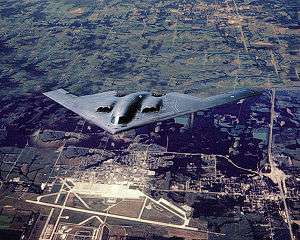Whiteman Air Force Base
| Whiteman Air Force Base | |
|---|---|
| Part of Air Force Global Strike Command (AFGSC) | |
| Located near: Knob Noster, Missouri | |
|
B-2 Over Whiteman | |
| Coordinates | 38°43′49″N 093°32′53″W / 38.73028°N 93.54806°W |
| Site information | |
| Controlled by |
|
| Site history | |
| Built | 1928 |
| In use | 1963 – present |
| Garrison information | |
| Garrison |
|
| Airfield information | |||||||||||
|---|---|---|---|---|---|---|---|---|---|---|---|
| Summary | |||||||||||
| Elevation AMSL | 871 ft / 265 m | ||||||||||
| Coordinates | 38°43′49″N 093°32′55″W / 38.73028°N 93.54861°WCoordinates: 38°43′49″N 093°32′55″W / 38.73028°N 93.54861°W | ||||||||||
| Website | www.whiteman.af.mil | ||||||||||
| Map | |||||||||||
 KSZL Location of Whiteman Air Force Base | |||||||||||
| Runways | |||||||||||
| |||||||||||
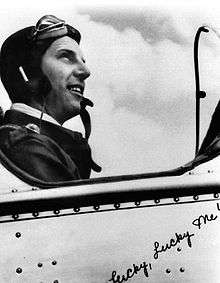

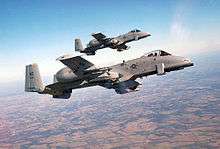

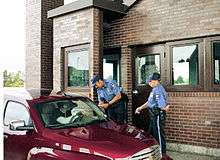
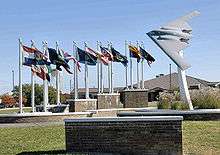
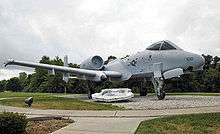

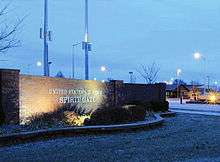
Whiteman Air Force Base (AFB) (IATA: SZL, ICAO: KSZL, FAA LID: SZL) is a United States Air Force base located approximately 2 miles (3.2 km) south of Knob Noster, MO; 10 miles (16 km) east of Warrensburg, MO, and 70 miles (110 km) east-southeast of Kansas City.
The host unit at Whiteman AFB is the 509th Bomb Wing (509 BW), assigned to the Eighth Air Force of the Air Force Global Strike Command. The 509 BW operates the B-2 Spirit Stealth Bomber, designed to be employed to strike high-value targets that are either out of range of conventional aircraft or considered to be too heavily defended for conventional aircraft to strike without a high risk of loss.
Whiteman AFB was established in 1942 as Sedalia Glider Base.
Overview
Whiteman AFB is a joint-service base, with Air Force, Army and Navy units. Its host unit is the U.S. Air Force's 509th Bomb Wing (509 BW). Tenant units include the Missouri Air National Guard's 131st Bomb Wing (131 BW), the Air Force Reserve Command's 442nd Fighter Wing (442 FW), the Missouri Army National Guard's 1st Battalion, 135th Aviation Regiment and the U.S. Navy Reserve's Maritime Expeditionary Security Force Unit 114.
Whiteman AFB is the only permanent base for the B-2 Spirit stealth bomber. Whiteman can launch combat sorties directly from Missouri to any part of the globe, engaging adversaries with nuclear or conventional weapon payloads. The 509th Bomb Wing first flew the B-2 in combat against Serbia in March 1999. Later, Whiteman B-2s led the way for America's military response to the terrorist attacks on New York and Washington D.C. in September 2001. B-2 bombers were the first U.S. aircraft to enter Afghanistan airspace in October 2001, paving the way for other coalition aircraft to engage Taliban and Al Qaeda forces. During these operations, the aircraft flew round-trip from Missouri, logging combat missions in excess of 40 hours – the longest on record.
Other aircraft assigned to Whiteman include the A-10 Thunderbolt II ground-attack fighter; the T-38 Talon jet trainer, and the AH-64 Apache attack helicopter.
Units
The 509th Bomb Wing (509 BW) consists of the following groups:
- 509th Operations Group (Tail Code: WM – carried on main landing gear doors of tailless B-2) B-2 Spirit; T-38 Talon
- 13th Bomb Squadron
- 393d Bomb Squadron
- 509th Operations Support Squadron
- 509th Maintenance Group
- 509th Aircraft Maintenance Squadron
- 509th Maintenance Squadron
- 509th Mission Support Group
- 509th Security Forces Squadron
- 509th Civil Engineering Squadron
- 509th Force Support Squadron
- 509th Medical Group
The 131st Bomb Wing (131 BW), a unit of the Missouri Air National Guard, is also located at Whiteman AFB as an associate unit of the 509th Bomb Wing. The 131 BW is operationally-gained by the Air Force Global Strike Command.
- 131st Operations Group
- 110th Bomb Squadron (Tail Code: WM) B-2 Spirit; T-38 Talon
- 131st Maintenance Group
- 131st Mission Support Group
- 131st Medical Group
The Air National Guard's 131st Bomb Wing and the Regular Air Force's 509th Bomb Wing have a unique relationship at Whiteman AFB, in that members of the two units work side-by-side on a daily basis. Active Guard and Reserve (AGR) and Air Reserve Technician (ART) personnel work full-time, with part-time Traditional Guardsmen (TG) pilots funded for Additional Flying Training Periods and serving five to ten days per month. Otherwise, the majority of the 131st Bomb Wing, primarily support personnel, performs military duty at Whiteman only one weekend per month for drill. In August 2013, the 131st Bomb Wing became the only Air National Guard bomb wing to be certified to conduct nuclear operations.[1]
The 442nd Fighter Wing (442 FW), an Air Force Reserve Command unit controlled by the Tenth Air Force, is a tenant unit at Whiteman AFB and is operationally gained by the Air Combat Command. The 442 FW flies the A-10 Thunderbolt II.
- 442nd Operations Group (Tail Code: KC)
- 442nd Maintenance Group
- 442nd Mission Support Group
In addition, the wing boasts the 442nd Medical Squadron, as well as a wing staff. There are also two geographically separated units (GSUs) that report to the 442nd Fighter Wing. The 710th Medical Squadron and 610th Intelligence Operations Flight, both located at Offutt Air Force Base, Nebraska, look to the 442 FW for support in accomplishing their missions.
In addition, the 476th Fighter Group (476 FG) stationed at Moody Air Force Base, Georgia, is an Air Force Reserve Command unit under the oversight of the 442 FW as a geographically-separated unit (GSU). Otherwise, the 476 FG is linked to the active duty 23rd Fighter Group (23 FG) and 23rd Wing (23 WG) at Moody. The 442 FW oversees the 476 FG's administrative and mission-support needs not provided by Moody's host active duty wing. The 476 FG consists of the following squadrons and flights:
- 76th Fighter Squadron (Tail Code: FT) A-10 Thunderbolt II
- 476th Maintenance Squadron
- 476th Medical Flight
The Missouri Army National Guard's 1st Battalion, 135th Aviation Regiment is also a tenant unit at Whiteman AFB, flying the AH-64 Apache.
The Navy Reserve's Maritime Expeditionary Security Force, Division 11, is also located at Whiteman AFB, providing light, mobile, short-duration, point-defense Anti-Terrorism Force Protection forces for USN ships and aircraft and other high-value assets in locations where U.S. or host-nation security infrastructure is either inadequate or non-existent.
History
Named in honor of 2nd Lieutenant George Allison Whiteman (1919–1941). On 7 December 1941, Lieutenant Whiteman attempted to take off from Bellows Field during the Japanese attack on Pearl Harbor. Hit by enemy fire, his P-40 Warhawk crashed and Lieutenant Whiteman became the first member of the United States armed forces to die in aerial combat in World War II.[2]
World War II
The base had its beginnings in 1942 when U.S. Army Air Corps officials selected the site of the present-day base to be the home of Sedalia Army Air Field and a training base for WACO glider pilots.
In May 1942, construction workers descended upon an area known to locals as the "Blue Flats" because of the color of the soil and began building a railroad spur for the new air base. The new railroad line, laid by the Missouri Pacific Railroad, was only the beginning. The runways, the main impetus for the base, required 27,800 square yards of concrete. The entire runway was poured in 18 hours during a driving Midwestern rainstorm. The base reached a major milestone on 6 August 1942 when the Army declared the field officially open.
In November 1942, the installation became Sedalia Army Air Field and was assigned to the I Troop Carrier Command of the U.S. Army Air Forces. The field served as a training site for glider tactics and paratroopers and was one of the eight bases in the United States dedicated to training glider pilots for combat missions performed by the Troop Carrier Command. Pilots flew C-46 or C-47 transports and several types of cargo and personnel gliders, usually the Waco CG-4A. The forest green, fabric-covered gliders could carry 15 fully equipped men or a quarter-ton truck plus a smaller crew. They were towed in either single or double tow behind the transport aircraft and could land on fields not equipped for larger aircraft.
In the opening months of 1945 Sedalia AAFld began converting from C-47s to C-46s. By July and August 1945, the base had assumed the function of providing central instructor training for all combat crew training bases throughout the I Troop Carrier Command. This program provided skills and teaching methods in all aspects of troop carrier flying.
During the massive demobilization in the mid-1940s, the base closed and most of the buildings were abandoned.
Cold War
In August 1951, SAC selected the renamed-Sedalia AFB to be home to one of its new bombardment wings with the first all-jet bomber, the B-47 Stratojet, and the KC-97 Stratofreighter aerial refueling aircraft assigned to the unit. Construction of facilities was conducted by the 4224th Air Base Squadron until 20 October 1952, when the base was turned over to the 340th Bombardment Wing (340 BMW). The first B-47 arrived on 25 March 1954 and the first KC-97 arrived six months later.
On 3 December 1955, Sedalia AFB became Whiteman AFB in honor of 2nd Lt George A. Whiteman. A native of Sedalia, Whiteman was one of the first American airmen killed in World War II when the Japanese attacked Pearl Harbor, Hawaii, on 7 December 1941. During the attack of Bellows Field, Oahu, Lieutenant Whiteman managed to reach his fighter aircraft. While attempting to take off, enemy fighters attacked his plane and Whiteman's P-40 crashed, fatally injuring the mid-Missouri native. By the time rescue teams reached the aircraft, Whiteman had died.
Construction on Whiteman continued throughout the 1950s. During this period, the Air Force built military family housing units as well as a base pool and gymnasium. However, a project on a much grander scale soon overshadowed this flurry of construction.
Minuteman missiles (1961–1995)
In June 1961, the Department of Defense chose Whiteman to host the fourth Minuteman ICBM wing. On 17 January 1962, the joint venture team of Morrison-Knudsen, Paul Hardeman, Inc., Perini Corporation, and C.H. Leavell & Co. received the prime contract for construction of hardened, underground launch facilities and 15 launch control centers. The project called for the excavation of over 2,000,000 cubic yards of earth and rock.[3]
The contractors used 168,000 cubic yards of concrete, 25,355 tons of reinforcing steel and 15,120 tons of structural steel. In addition, the project called for the installation of a vast underground intersite cable network. If laid end to end in a straight line, this cable would stretch from Whiteman AFB to 100 miles (160 km) beyond Los Angeles. Construction of the complex was officially completed in June 1964 at a cost of $60,665,000. The missile silos were built with a minimum separation of three miles between each one, so that the resulting silo field occupied around 10,000 square miles.[4]
Before completion of the construction, SAC activated the 351st Strategic Missile Wing at Whiteman on 1 February 1963. The 340th Bombardment Wing gradually phased out operations during the same year with its aircraft and remnants transferring to Bergstrom AFB, Texas, on 1 September 1963.
After the change in 1963 from a bomber base to an ICBM site, life on Whiteman remained relatively stable throughout the 1960s and 1970s although there were programs to continually update and improve the base's weapons systems. Whiteman deployed 150 Minuteman I missiles controlled from the 15 underground launch centres. In 1966 a major program was initiated to replace the Minuteman I missiles with Minuteman II.[4]
Several new buildings emerged from time to time as the base matured. However, with the beginning of the 1980s, a new construction phase started. New missile operations, maintenance and security police facilities as well as several enlisted dormitories marked the start of a new era. Meanwhile, the base continued to lead the way. In the late 1980s, the 351st fielded the first female Minuteman missile crew, the first mixed sex Minuteman crew, and the first squadron commander to pull alert in the Minuteman system.
Under the provisions of the Strategic Arms Reduction Treaty, the Minuteman II system was decommissioned. The first launch control centre was shut down on 8 January 1993 and the final warhead removed from the site on 7 May 1993. The treaty mandated the demolition of all of the silos, and this was carried out starting in December 1993 when the first silo was imploded. The final missile was removed from the site on 18 May 1995.[4] One of the launch control centres, Oscar-1, still exists and is maintained as a museum.[4]
B-2 bombers
On 5 January 1987, Congressman Ike Skelton announced that the first deployment of the B-2 Advanced Technology Bomber would be at Whiteman. Beginning in 1988, a massive construction wave that created new buildings designed for B-2 operations, maintenance and support activities swept over the base.
On 1 July 1990, the 100th Air Division activated at Whiteman and assumed host responsibilities for the base. Accordingly, the 351st Combat Support Group and the 351st Security Police Group, along with their assigned units and the squadrons under the deputy commander for resource management, inactivated at Whiteman. Concurrently, the Air Force activated equivalent squadrons bearing the 800th designator to replace the inactivated 351st units.
Modern era
Several months after the air division's activation, on 30 Sep 1990, the 509th Bomb Wing moved its headquarters to Whiteman albeit in an unmanned and non-operational state.
However, the 100th AD's tenure at Whiteman did not last long as SAC inactivated the unit on 26 July 1991. Similarly, Whiteman's host unit responsibilities reverted to the 351st.
During the next two years, Whiteman's building infrastructure continued to grow as the arrival date of the first B-2 drew nearer. Meanwhile, another change developed in the Air Force.
With the end of the Cold War, the Air Force disestablished Strategic Air Command, Tactical Air Command and Military Airlift Command on 1 June 1992. In their place arose two new organizations, one of which was Air Combat Command, the 509th's newer, higher headquarters.
On 1 April 1993, the 509th returned to operational status when people from Detachment 509, the base's B-2 overseers for the past two years, were formally assigned to the wing. Then, on 1 July 1993, the 509th accepted the host responsibilities for Whiteman from the 351st and a new era dawned for the base. Several days later, on 20 July 1993, flying operations returned to the base after a 30-year hiatus when the first permanently assigned T-38 landed at Whiteman.
Then, on 17 Dec 1993, the event that Whiteman had long-awaited finally arrived. On that day, at approximately 2 pm, a dark jet bomber swooped from the sky and landed on the Whiteman runway. Amid much fanfare, the first operational B-2, The Spirit of Missouri, had arrived. Less than a week later, on 22 Dec 1993, Whiteman again made history as it generated the first B-2 sortie from the base.
On 12 June 1994, the base welcomed the 442nd Fighter Wing (442 FW). The 442nd, an Air Force Reserve Command unit operating the A-10 Thunderbolt II, was previously assigned to Richards-Gebaur AFB, Missouri, transferring to Whiteman after the BRAC-directed closure of Richards-Gebaur.
Yet, the 442nd was not really a newcomer to the base. On 1 Sep 1943, the then-called 442nd Troop Carrier Group activated at Sedalia Army Air Field. It subsequently remained at the base until December 1943.
In 1995 the base also lost one of its long-time resident units. On 31 July 1995, the 351st Missile Wing officially inactivated, ending its 33-year association with Whiteman AFB.
On 4 October 2008, the Missouri Air National Guard's 131st Fighter Wing relinquished its F-15 Eagle aircraft to other Air National Guard fighter wings, was renamed the 131st Bomb Wing, and officially moved from its former base at Lambert-St. Louis International Airport to Whiteman Air Force Base to create a classic association with the active duty 509th Bomb Wing.
On 1 Feb 2010, the 509th Bomb Wing at Whiteman Air Force Base became part of the newly created Air Force Global Strike Command. Also in February 2010, the 20th Reconnaissance Squadron, an Air Combat Command unit and ground control station for the MQ-1 Predator, also began operation at the base.[5]
Previous names
Established as: Sedalia Glider Base, 1 March 1942
- Army Air Forces Station at Sedalia, MO, c. 1 May 1942
- Sedalia Army Air Base, 8 August 1942
- Army Air Base, Warrensburg, MO, 23 September 1942
- Sedalia Army Airfield, 27 October 1942
- Army Air Base, Knob Noster, MO, 31 October 1942
- Sedalia Air Force Auxiliary Field, 24 June 1948
- Sedalia Air Force Base, 1 August 1951
- Whiteman Air Force Base, 1 October 1955
Major commands to which assigned
- Air Transport Command, 26 June 1942 (rdsgd I Troop Carrier Command, July 1942)
- Continental Air Forces, 16 April 1945
- Tactical Air Command, 21 March 1946
- Inactivated 1 September 1946
- Air Materiel Command, 14 December 1947 (during inactive status)
- Activated 1 July 1951
- Strategic Air Command, 1 August 1951
- Air Combat Command, 1 June 1992
- Air Force Global Strike Command, 1 February 2010
Major units assigned
- 50th Troop Carrier Wing, 11 September 1942 – 26 April 1943
- 53d Troop Carrier Wing, 15 April 1943 – 25 July 1943
- 61st Troop Carrier Wing, 23 July 1943 – 4 October 1945
- 53d Troop Carrier Wing, 1 October 1945 – 1 March 1946
- 340th Bombardment Wing, 20 October 1952 – 1 September 1963
- 17th Air Division, 15 July 1959 – 30 June 1971
- 351st Strategic Missile Wing, 1 February 1963 – 31 July 1995
- 509th Bomb Wing, 30 September 1990 – present
- 442nd Fighter Wing, 12 June 1994 – present
- 131st Bomb Wing, Missouri Air National Guard, 4 October 2008 – present
- 20th Reconnaissance Squadron, February 2010 – present[5]
Geography
Whiteman AFB is located at 38°43′58″N 93°33′17″W / 38.73278°N 93.55472°W (38.732758, −93.554851).[6]
According to the United States Census Bureau, the CDP has a total area of 13.4 km² (5.2 mi²), all land. Part of the base is a census-designated place (CDP); it had a population of 3,814 at the 2000 census.
Nearby towns include Knob Noster, Warrensburg and Sedalia. The nearest major city is Kansas City, Missouri.
Demographics
As of the census[7] of 2000, there were 3,814 people, 931 households, and 901 families residing in the CDP. The population density was 284.8/km² (737.7/mi²). There were 982 housing units at an average density of 73.3/km² (189.9/mi²). The racial makeup of the CDP was 81.8% White, 9.7% Black or African American, 0.7% Native American, 1.7% Asian, 0.5% Pacific Islander, 2.2% from other races, and 3.5% from two or more races. Hispanic or Latino of any race were 5.7% of the population.
There were 931 households out of which 79.2% had children under the age of 18 living with them, 90.1% were married couples living together, 4.2% had a female householder with no husband present, and 3.2% were non-families. 2.7% of all households were made up of individuals and none had someone living alone who was 65 years of age or older. The average household size was 3.53 and the average family size was 3.56.
In the CDP, the population was spread out with 37.6% under the age of 18, 25.7% from 18 to 24, 35.5% from 25 to 44, 1.2% from 45 to 64, and 0.1% who were 65 years of age or older. The median age was 21 years. For every 100 females there were 125.5 males. For every 100 females age 18 and over, there were 130.9 males.
The median income for a household in the CDP was $33,664, and the median income for a family was $32,586. Males had a median income of $22,095 versus $16,466 for females. The per capita income for the CDP was $11,538. About 5.6% of families and 7.3% of the population were below the poverty line, including 7.3% of those under age 18 and none of those age 65 or over.
Whiteman in pop culture
Whiteman AFB was one of the settings for the 1983 television movie The Day After. The base plays a prominent role in the film, for the 150 Minuteman II missile silos stationed there at the time, and its proximity to the rest of the characters.
In the Dale Brown novel Plan of Attack, the base is destroyed by two Russian nuclear-tipped AS-17 Krypton cruise missiles. In the aftermath, only two B-2 stealth bombers survive.
In the movie Broken Arrow, John Travolta and Christian Slater fly a "prototype" B-2 from Whitman on a training sortie over the Utah desert.
See also
References
- ↑ http://www.af.mil/News/ArticleDisplay/tabid/223/Article/466814/first-ang-bomb-wing-certified-for-nuclear-operations.aspx
- ↑ Mueller, Robert (1989). "Air Force Bases, Vol. I, Active Air Force Bases Within the United States of America on 17 September 1982" (PDF). Office of Air Force History. p. 583. Retrieved 23 October 2015.
- ↑ Staff. "Minuteman Base in Missouri." The Em Kayan, August 1962.
- 1 2 3 4 "Oscar - 01 launch control facility". Whiteman AFB.
- 1 2 O'Connor, Phillip, "Unmanned Aircraft Emerge As Key in Targeting Terrorists", St. Louis Post-Dispatch, 10 May 2011, p. 1.
- ↑ "US Gazetteer files: 2010, 2000, and 1990". United States Census Bureau. 2011-02-12. Retrieved 2011-04-23.
- ↑ "American FactFinder". United States Census Bureau. Retrieved 2008-01-31.
Other sources
-
 This article incorporates public domain material from the Air Force Historical Research Agency website http://www.afhra.af.mil/.
This article incorporates public domain material from the Air Force Historical Research Agency website http://www.afhra.af.mil/. -
 This article incorporates public domain material from the United States Government document "Whiteman Air Force Base".
This article incorporates public domain material from the United States Government document "Whiteman Air Force Base". - Maurer, Maurer. Air Force Combat Units of World War II. Washington, DC: U.S. Government Printing Office 1961 (republished 1983, Office of Air Force History, ISBN 0-912799-02-1).
- Ravenstein, Charles A. Air Force Combat Wings Lineage and Honors Histories 1947–1977. Maxwell Air Force Base, Alabama: Office of Air Force History 1984. ISBN 0-912799-12-9.
- Mueller, Robert, Air Force Bases Volume I, Active Air Force Bases Within the United States of America on 17 September 1982, Office of Air Force History, 1989
External links
| Wikimedia Commons has media related to Whiteman Air Force Base. |
- Whiteman AFB history from Strategic-Air-Command.com
- Whiteman AFB at GlobalSecurity.org
- Resources for this U.S. military airport:
- FAA airport information for SZL
- AirNav airport information for KSZL
- ASN accident history for SZL
- NOAA/NWS latest weather observations
- SkyVector aeronautical chart for KSZL
